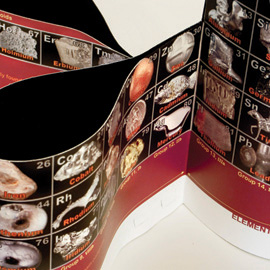The 3D Alexander Arrangement of Elements periodic tables

The 'lay public' includes new students, of course, and the Alexander Arrangement of Elements (AAE) was designed to eliminate the confusion and apparent inconsistencies in the flat table by arranging the elements contiguously and continuously according to atomic number without disturbing any accepted group and property interrelationships previously found in the periodic chart.
The resulting 3D form has three parts looping outwards from a relatively central point. The elements in Groups 0, Ia, IIa, IIIb, IVb, Vb, and VIIIb (the Main Group) are in the narrowest and tallest part, a semi-tube. From the lower part of this component the sides loop showing the D-block and the F-block.
Printed flat, the AAE is die cut and scored for separation of the model parts for assembly into a 3D model by teacher or student (DeskTopper version shown left) by folding, looping, and insertion of tabs in slots. All element data then have a common vertical plane so their atomic number sequence can be traced with a finger on the surface by their without changing direction or leaving the surface.
The most useful feature for teaching new students - aside from the motivation gained by the unique, rational, and attractive shape - is the integration of the Rare Earths, usually dislocated on standard flat charts.
During Glenn Seaborg's work on nuclear energy in the Manhattan Project during WWII he first discovered/invented many new radioactive elements, then placed these in a separate location - the familiar separate f-block - earning a later Nobel Prize for his insight. Before he died he had an Alexander Arrangement and notified Roy that this 3D method was now the correct way to show the Rare Earths in the periodic table.

Combining the extraordinarally beautiful element photography of Theodore Gray in latest Alexander Arrangement should speed and improve classroom introduction of the periodic table, providing logic and clarity as well as reality.
Photos are unavailable of elements past Plutonium for good reason - there are no element substances to photograph. So the table we developed is one that will always avoid the lab-created elements, those that almost universally have no useful purpose.
Students need only to learn about those elements with which they might be doing chemistry (and can be photographed), so this learning aid, portraying only natural element substances, will never be obsolete, thus is called the Forever Periodic Table!